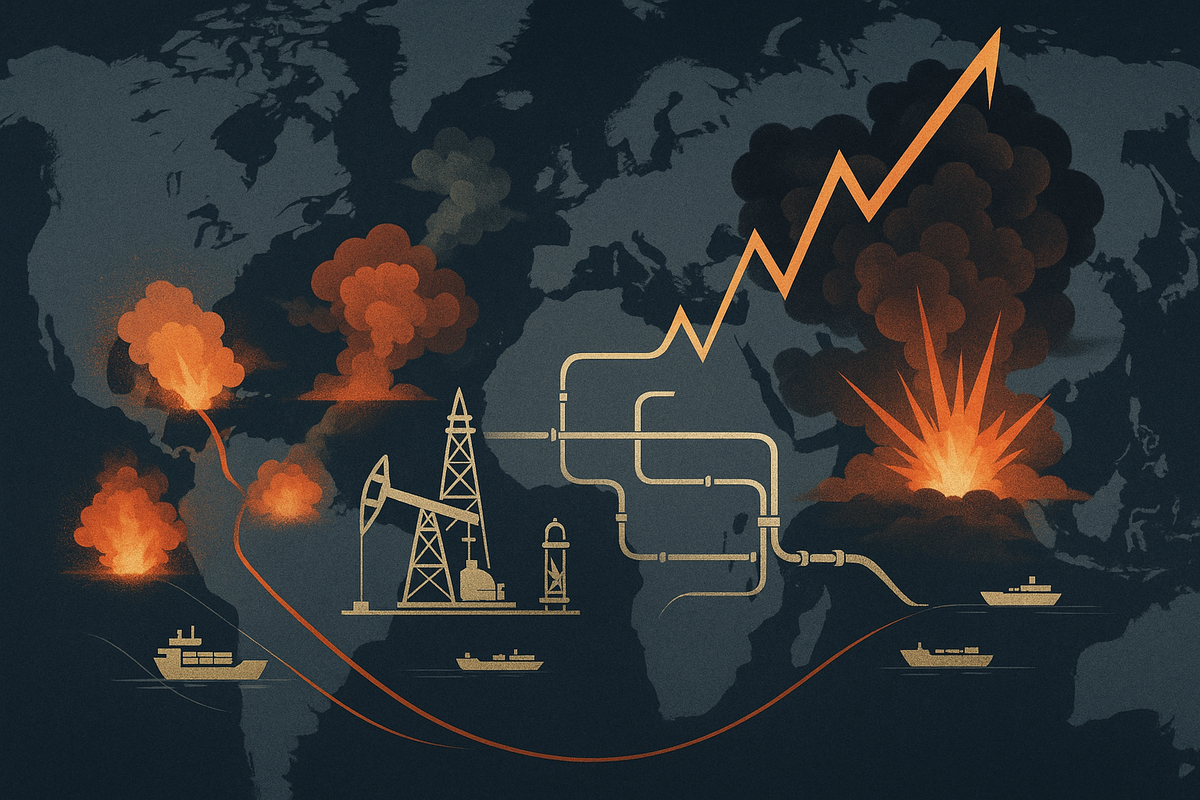Geopolitical Storm Brews: How Global Tensions Are Rerouting Energy Markets and Fueling Volatility

Global energy markets are currently navigating a turbulent sea of geopolitical tensions, with persistent conflicts and strategic competition directly fueling price volatility and embedding significant risk premiums. From the Red Sea's critical shipping lanes to the volatile heart of the Middle East and the battlegrounds of Eastern Europe, a confluence of crises is disrupting traditional trade patterns, escalating logistical costs, and forcing a fundamental re-evaluation of energy security worldwide. The ripple effects are profound, touching everything from daily fuel prices to the long-term investment strategies of multinational corporations.
This intricate web of geopolitical flashpoints is creating an unprecedented environment of uncertainty. The sustained attacks by Houthi rebels on commercial vessels in the Red Sea have choked off a vital maritime artery, compelling a costly and time-consuming rerouting of global trade. Simultaneously, escalating strategic competition and direct conflicts in the Middle East, particularly involving Israel and Iran, have added an estimated $5-15 per barrel risk premium to global oil prices. Further east, the ongoing conflict in Eastern Europe continues to fundamentally disrupt the traditional energy supply landscape for both oil and natural gas, particularly impacting Europe's energy matrix.
The Epicenter of Disruption: What Happened and Why It Matters
The current state of global energy markets is a direct consequence of several interconnected geopolitical events, each contributing to a climate of heightened risk and unpredictability. The Red Sea, a crucial conduit for global trade, has become a hotbed of Houthi attacks since November 2023. These assaults have targeted commercial vessels, including oil and LNG carriers, forcing major shipping and energy companies like BP (BP.L) and Shell (SHEL.L) to temporarily suspend transits through the Suez Canal. This detour around the Cape of Good Hope adds an extra 10-15 days, and sometimes up to 45 days for tankers, to voyages, significantly increasing fuel consumption and operational costs. The impact on shipping volumes is stark: a 42% decrease in cargo ships through the Suez Canal from December 2023 to February 2024, with container shipments plummeting by 75-90% and LNG carrier transits falling by 73%. This disruption directly translates to a $2-4 per barrel risk premium on oil prices and a surge in war risk insurance premiums, now reaching 0.5-1% of a vessel's hull value.
In the Middle East, a region holding approximately 30% of the world's oil supply, escalating tensions—particularly between Israel and Iran—have sent shockwaves through energy markets. A significant escalation in June 2025, involving an Israeli airstrike targeting Iranian infrastructure, saw Brent crude contracts jump by 8-13%, reaching $75-78 per barrel, and then surging over 10% within weeks. This conflict has instilled a substantial geopolitical risk premium, estimated at $5-15 per barrel, reflecting fears of broader supply disruptions. The Strait of Hormuz, a chokepoint through which nearly a third of global oil and natural gas shipping passes, remains a critical vulnerability. Experts project that a complete closure of this strait could send oil prices soaring to $100-$125 per barrel. The conflict has already impacted regional energy infrastructure, with an Israeli strike temporarily halting one processing train at Iran's South Pars gas field, cutting gas output.
Concurrently, the conflict in Eastern Europe continues to reshape the global energy landscape, particularly for natural gas in Europe. Following the full-scale invasion in February 2022, oil prices surged by approximately 40%, and European natural gas prices by 180% in the initial two weeks. European benchmark natural gas prices rose by an average of 163% in 2022, contributing significantly to inflation. While Europe has successfully diversified away from Russian pipeline gas, with flows via Eastern Europe halting by the end of 2024, Ukraine's recent drone attacks on Russian energy infrastructure, such as refineries and export terminals, continue to add uncertainty and contribute to slight oil price increases. The EU is also planning to accelerate a ban on Russian LNG imports, further signaling a definitive shift away from Russian energy dependence.
Market Tremors: Winners, Losers, and Industry Shifts
The current geopolitical climate is creating a distinct bifurcation in the energy market, producing clear winners and losers while fundamentally altering industry dynamics. Shipping companies, particularly those heavily reliant on the Red Sea route, are facing significant financial headwinds. Major players like A.P. Møller-Mærsk (MAERSK.CO), Evergreen Line, and HMM are incurring substantial costs due to longer transit times around the Cape of Good Hope, increased fuel consumption, and soaring war risk insurance premiums. These added expenses erode profit margins and disrupt global supply chains, leading to potential delays and higher consumer prices for goods.
For integrated energy giants, the impact is multifaceted. Companies like ExxonMobil (XOM.N) face heightened oil price volatility, which directly affects their upstream exploration and production profitability. Furthermore, increased logistical costs for their global operations, particularly if they rely on affected shipping lanes, can squeeze downstream margins. The conflict in Eastern Europe also forced companies like ExxonMobil (XOM.N) to re-evaluate their geopolitical risk exposure, leading to a $4.6 billion loss from exiting the Sakhalin-1 project in Russia, although reports suggest a potential re-entry in 2025. Countries heavily dependent on specific energy imports from conflict zones are also vulnerable; China, for instance, which purchases over 90% of Iranian oil, would be severely impacted by any complete halt in Iranian exports.
Conversely, some sectors and companies are finding themselves in a relatively advantageous position. LNG producers and exporters, especially from the United States, are benefiting from Europe's urgent need to diversify its natural gas supply away from Russia. With European natural gas prices remaining elevated and new LNG infrastructure investments, these companies are securing long-term contracts and expanding their market share. Companies involved in the development of alternative energy sources or those with highly diversified global supply chains are also proving more resilient. The crisis is accelerating investment in energy independence and resilience, creating opportunities for innovation and new infrastructure development in less volatile regions.
Broader Implications: Reshaping the Global Energy Landscape
The current geopolitical energy crisis extends far beyond immediate price fluctuations; it is fundamentally reshaping the global energy landscape, with wide-ranging implications for industry trends, regulatory frameworks, and international relations. This period marks an accelerated shift away from highly centralized and vulnerable energy supply chains towards more diversified and resilient models. Europe's rapid pivot from Russian pipeline gas to global LNG imports and renewable energy investments is a prime example of this trend, demonstrating a willingness to prioritize energy security over cost efficiency. This shift has ripple effects, intensifying competition for LNG cargoes globally and driving investment in new liquefaction and regasification terminals.
The persistent disruptions underscore the critical importance of maritime security and the vulnerability of global chokepoints. Governments and international bodies are likely to increase focus on safeguarding vital shipping lanes, potentially leading to enhanced naval presence and collaborative security initiatives. This could also spur investment in alternative overland trade routes or pipeline infrastructure where feasible, though such projects are often complex and expensive. Regulatory and policy implications are significant, with governments likely to review strategic energy reserves, incentivize domestic production, and potentially implement new trade restrictions or sanctions in response to evolving geopolitical realities. The EU's planned accelerated ban on Russian LNG imports is a clear indication of this hardening stance.
Historically, geopolitical conflicts have always been a major determinant of energy prices and trade patterns. The current situation draws parallels to the 1973 Yom Kippur War and the Iranian Revolution, both of which led to dramatic oil price spikes and significant reconfigurations of global energy politics. However, today's interconnected world means that the ripple effects are more immediate and widespread, affecting not just energy prices but also inflation, economic growth, and the stability of global supply chains across various industries. The current events are forcing a re-evaluation of globalization's vulnerabilities and the need for greater regionalization and self-sufficiency in critical resources.
What Comes Next: Navigating the Uncertain Future
The path forward for global energy markets remains fraught with uncertainty, demanding constant vigilance from policymakers, industry leaders, and investors alike. In the short term, the immediate focus will be on the de-escalation of existing conflicts and the securing of critical trade routes. Any significant reduction in Houthi attacks or a diplomatic breakthrough in the Middle East could quickly ease some of the current risk premiums and reduce shipping costs. Conversely, any further escalation, particularly involving major oil-producing nations or a direct threat to the Strait of Hormuz, would likely trigger severe price spikes and potentially lead to global economic instability.
Longer term, the energy industry faces a period of strategic pivots and adaptations. Companies will increasingly prioritize supply chain resilience, potentially diversifying sourcing, investing in storage capacity, and exploring new logistical solutions. The push towards decarbonization may also see an accelerated adoption of renewable energy sources as nations seek to reduce their reliance on volatile fossil fuel markets. Market opportunities will emerge in areas like LNG infrastructure development, cybersecurity for energy grids, and advanced shipping technologies that can navigate complex geopolitical environments. Challenges will include managing sustained higher operational costs, navigating evolving regulatory landscapes, and adapting to shifting geopolitical alliances.
Potential scenarios range from a gradual stabilization of energy markets as new supply chains and security measures are established, to a prolonged period of elevated volatility and prices if conflicts persist or intensify. Investors should closely monitor geopolitical developments, particularly in the Red Sea, the Middle East, and Eastern Europe. Attention should also be paid to the strategic responses of major energy companies, government policy shifts regarding energy security and trade, and the broader macroeconomic indicators that will reflect the impact of these energy market disruptions on global inflation and economic growth.
Conclusion: A New Era of Energy Geopolitics
The current confluence of geopolitical tensions—from the Red Sea to the Middle East and Eastern Europe—has ushered in a new era for global energy markets characterized by persistent volatility, elevated risk premiums, and fundamental disruptions to traditional trade patterns. The events of the past year have underscored the fragility of global supply chains and the profound impact that regional conflicts can have on worldwide energy security and economic stability. The estimated $5-15 per barrel risk premium on oil prices and the significant rerouting of global shipping are not merely temporary aberrations but rather embedded costs reflecting a new geopolitical reality.
Moving forward, the energy market will continue to be shaped by these powerful forces. Companies and nations alike must prioritize resilience, diversification, and robust risk management strategies to navigate this complex environment. Europe's successful, albeit costly, pivot away from Russian natural gas serves as a powerful testament to the necessity of strategic energy independence. Investors should prepare for continued market uncertainty, with energy prices remaining highly sensitive to geopolitical developments.
The lasting impact of these events will likely be a more fragmented and regionalized global energy landscape, driven by a renewed focus on national energy security and a cautious approach to international trade dependencies. What investors should watch for in the coming months are not just the headlines from conflict zones, but also the strategic investments in new energy infrastructure, the evolution of international energy partnerships, and the policy decisions that will ultimately determine the shape of the global energy market for decades to come. The era of cheap, easily accessible energy from stable supply lines appears to be fading, replaced by a more complex and geopolitically charged reality.



